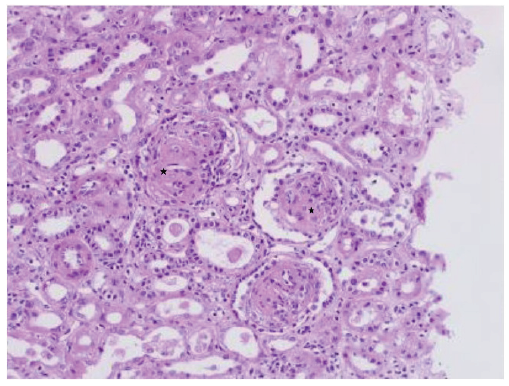Translate this page into:
Novel TRPV4 Gene Mutation and Diffuse Mesangial Sclerosis in Steroid Resistant Nephrotic Syndrome
Corresponding author: Manoj Anant Dhanorkar, Department of Nephrology, All India Institute of Medical Sciences, Nagpur, India. E-mail: dhanorkarmanoj@gmail.com
-
Received: ,
Accepted: ,
How to cite this article: Sarkar M, Chellappan A, Choudhary A, Dhanorkar MA. Novel TRPV4 Gene Mutation and Diffuse Mesangial Sclerosis in Steroid Resistant Nephrotic Syndrome. Indian J Nephrol. doi: 10.25259/IJN_808_2024
Dear Editor,
Podocytopathy seen in children with nephrotic syndrome (NS) usually responds to empirical oral prednisolone therapy. About 15-20% of patients with NS have steroid resistant nephrotic syndrome (SRNS). Children with SRNS lacking syndromic features are evaluated with kidney biopsies and monogenic inherited genetic mutation analyses.
A 2-year-old boy born to 3rd-degree consanguineously married parents, developed NS. He received 6 weeks of oral steroids (60 mg/m2/day) but was referred to our institute for persistent proteinuria.
He was stunted, wasted, and hypertensive. Secondary causes of NS were ruled out. His serum creatinine was 1.25 mg/dL (estimated glomerular filtration rate = 25 mL/min/1.73m2), spot urine protein-creatinine ratio of 21337 mg/g. Light microscopy of kidney biopsy suggested diffuse mesangial sclerosis (DMS) [Figure 1]. Immunofluorescence was negative. Whole exome sequencing by next-generation sequencing revealed an autosomal dominant, heterozygous mutation in exon 2 of the TRPV4 gene, a variant of unknown significance on chr12:g.109814553G>T;c.244C>A. Sanger sequencing revealed that the variant was present in the father and absent in the mother. The child was initiated on cyclosporine and later on peritoneal dialysis after progressing to kidney failure.

- Diffuse mesangial sclerosis shown as widespread global mesangial sclerosis and few focal and segmental lesions involving the capillary tufts (black stars), Light microscopy, hematoxylin and eosin stain, 40x.
DMS is a common cause of SRNS with a poor outcome. The transient receptor potential (TRPV4) receptor is expressed in various body tissues and renal podocytes.1,2 TRPV4 plays a key role in cell death by mediating endoplasmic reticulum stress, oxidative stress, and inflammation.3,4 Mutation of the TRPV4 gene may lead to abnormal growth of podocytes. TRPV4 also regulates the filtration barrier in podocytes. Therefore, its receptors can be considered promising targets for controlling proteinuria.5
Acknowledgement
We acknowledge the Department of Pediatrics and Pediatrics Surgery. We would like to acknowledge the Medgenome lab for providing genetic evaluation services and Lal Path labs for providing kidney biopsy service.
Conflicts of interest
There are no conflicts of interest.
References
- The transient receptor potential family of ion channels. Genome Biol. 2011;12:218.
- [CrossRef] [PubMed] [PubMed Central] [Google Scholar]
- The vanilloid transient receptor potential channel TRPV4: From structure to disease. Prog Biophys Mol Biol. 2010;103:2-17.
- [CrossRef] [PubMed] [Google Scholar]
- Transient receptor potential vanilloid 4 channel deficiency aggravates tubular damage after acute renal ischaemia reperfusion. Sci Rep. 2018;8:4878.
- [CrossRef] [PubMed] [PubMed Central] [Google Scholar]
- Transient receptor potential vanilloid 1 (TRPV1), TRPV4, and the kidney. Acta Physiol (Oxf). 2013;207:546-64.
- [CrossRef] [PubMed] [Google Scholar]
- Human podocytes express functional thermosensitive TRPV channels. Br J Pharmacol. 2017;174:4493-507.
- [CrossRef] [PubMed] [PubMed Central] [Google Scholar]






